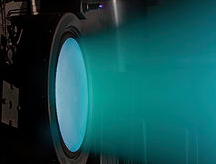
The engine that could ... and did ... pass the muster. Aerojet Rocketdyne’s NEXT-C ion propulsion engine has successfully cleared NASA’s critical design review (CDR), confirming the technology achieved all program requirements and is ready for final production of the flight units.
NASA’s Evolutionary Xenon Thruster-Commercial (NEXT-C) was developed by NASA and is being commercialized by Aerojet Rocketdyne. NEXT-C has 7kW of maximum power and greater than 4100s specific impulse (Isp). Its high Isp and flexible operational capabilities make NEXT ideal for scientific space missions.

Image of NASA's Evolutionary Xenon Thruster (NEXT) operation in vacuum chamber
NEXT-C will be the ion thruster used on a 2021 mission, named DART (Double Asteroid Redirection Test), led by the Johns Hopkins University Applied Physics Laboratory for NASA. DART is a kinetic impact mission designed to collide with a moonlet around the Didymos asteroid and slightly alter its orbit. This mission will be a critical step in demonstrating NASA’s impact threat mitigation capabilities for redirection of a potentially hazardous object such as an asteroid.
Eileen Drake, CEO and President of Aerojet Rocketdyne said that serving as the primary propulsion source for DART, NEXT-C will establish a precedent for future use of electric propulsion to enable ambitious future science missions. Electric propulsion reduces overall mission cost without sacrificing reliability or mission success.
Under a cost-sharing agreement with NASA’s Science Mission Directorate through the agency’s Glenn Research Center, Aerojet Rocketdyne is developing the NEXT-C electric propulsion engine and power processing unit. In addition to DART, additional NEXT-C units may be launched on future NASA planetary missions.

